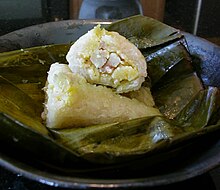Khao tom
 Khao tom can be either savory or sweet. This one from Laos, with a pork fat and mung bean filling, is savory. | |
| Alternative names | Khao tom mat |
|---|---|
| Course | Dessert |
| Place of origin | Mainland Southeast Asia |
| Region or state | Southeast Asia |
| Associated cuisine | Thailand and Laos |
| Main ingredients | Sticky rice, banana leaves |

Khao tom (Lao: ເຂົ້າຕົ້ມ; Thai: ข้าวต้ม, pronounced [kʰâ(ː)w tôm]; also spelled kao tom), or Khao tom mat (Thai: ข้าวต้มมัด, pronounced [kʰâ(ː)w tôm mát]) is a Southeast Asian dessert eaten by Laotian and Thai people, consisting of seasoned steamed sticky rice wrapped in banana leaves.[1] Other names include Khao tom mad, Khao tom kluai, Khao tom phat, and Khao tom luk yon.
Dishes that are similar to Khao tom mat can also be found in the Philippines (known as suman), Cambodia (known as ansom chek), Indonesia (lepet) and foods from Vietnam such as bánh tét and Bánh chưng.
Variants
This dessert can be either savoury (filled with pork fat and mung bean) or sweet (filled with coconut milk and banana). In Thailand, Khao tom is sometimes colored blue with Clitoria ternatea flowers.
The Khao tom variety with black beans is known as khao tom mat (ข้าวต้มมัด).[2]
Traditions
The Sai Krachat tradition (ประเพณีใส่กระจาด), also known as Suea Krachat or Soe Krachat in Phuan language is a merit-making Buddhist tradition of the Thai Phuan people of in Ban Mi District, Lopburi Province. It takes place on the eve of the Great Birth Sermon celebration. One day prior to the Sai Krachat Day, people wrap khao tom and grind rice for khao pun rice noodles. The next day is the Sai Krachat Day when people bring things such as bananas, sugar cane, oranges, candles, and joss sticks or other items to put into the bamboo baskets at the houses of the people they know, while the hosts bring the prepared food to welcome their guests. When the visitors wish to go home, the host gives khao tom mat as a souvenir in return called Khuen Krachat.[3]


In Thailand, khao tom mat is the symbol of couples because the couple are matched and bound together with thin bamboo-strip (string). Thai people believe that if a pair of people offer khao tom mat to monks on Khao Phansa Day, which is beginning of the 3 months of Buddhist lent during the rainy season and the time when monks retreat to a monastery and concentrate on Buddhist teachings,[4] married life will be smooth and there will be a stable love like a pair of khao tom mat.
Khao tom mat is also a traditional Thai dessert for Ok Phansa Day (the end of Buddhist lent in late October.), but it is then called Khao tom luk yon (Thai: ข้าวต้มลูกโยน). It is wrapped up in a young mangrove fan palm leaf (Thai: ใบกะพ้อ) with long-tails to hold before tossing them to a Buddha image, after which monks can carry them away.
See also
References
- ^ Sticky Rice with Bananas Archived 2013-06-03 at the Wayback Machine
- ^ "Sticky Rice, Banana and Black Beans Wrapped in Banana Leaf". Archived from the original on 2012-10-24. Retrieved 2012-11-28.
- ^ Steamed glutinous rice cakes with banana recipe
- ^ "Khao tom mat–banana sticky rice and coconut". Archived from the original on 2017-12-01. Retrieved 2017-01-09.
Bibliography
- Ramsay, Gordon. Gordon’s Great Escape Southeast Asia: 100 of my favourite Southeast Asian recipes. Retrieved 2013-09-08.
- "เมนูขนมไทย-ขนมหวาน | Wiparat Food - Part 5" (in Thai). Wiparat Food. Archived from the original on 2012-03-24. Retrieved 2013-09-08.
